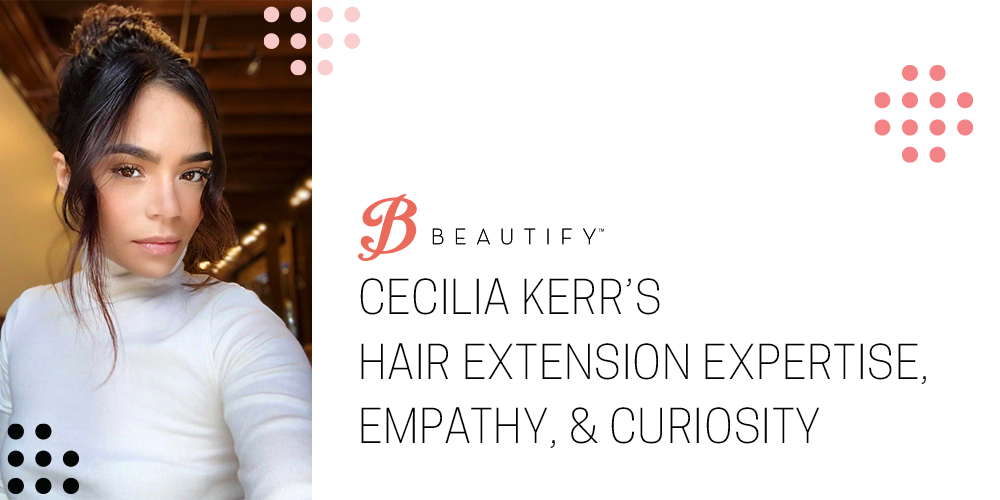
Cecilia Kerr: One of Hair Extension’s Most Exciting & Creative Experts
Cecilia Kerr has been offering clients her hair extension expertise for more than a decade now. She wears a ton of different professional hats. Licensed operator, product developer/inventor, extensions expert in both cutting and coloring – she does it all!
Cecilia also provides services as a local celebrity stylist. She’s consulted for various runway events, NBC, ABC, and the Livewell Network.
Her latest invention is the Tape Scrape. It’s a tool for stylists to remove tape residue from extensions to make the retaping process go more efficiently than ever before.
We’ve fortunately had the chance to have a very enlightening conversation with Cecilia. The following blog dives into the questions we asked and her informative answers.
First off, Cecilia, would you share your hair extension experience with hair loss clients?
To be able to empathize with clients as well as speak from a position of empirical experience, I try to wear the hair, or try the color, or get the chop before consulting about it. So with extensions, my own very first experience was wearing them. Tape-ins. Prior to that about a month, I had chopped my hair off.
Getting the hair back was so empowering, especially because long hair is more my vibe.
When I speak with clients who are experiencing unwanted hair loss, however, I stay aware of that and just do my best to listen for ways I can use my skill set to help them. Forgetting to listen can unravel the whole thing.
Once a meaningful conversation has taken place, I try to empower my client with information that opens a roadmap for them. Hair Loss can be daunting and can tend to sneak up on you, making anyone feel hopeless. In circumstances where it’s a symptom of a greater issue, it can even cause guilt for being worried about it at all.
At minimum, I can provide validation to a client, which can be so powerful. I can’t think of a client who had absolutely zero solution options, but it’s incredible how many walk in fearful, assuming that’s the case.
Listening > validate > empower with info > game plan.
Have a surefire game plan with your clients? Learn how our Beautify Bond strategy can support your tape-in extension process.
So, when would you recommend that a client opt for a hair system instead of hair extensions?
The most prevalent instance for unit customization is illness-related hair loss. Being in the same city as the best cancer treatment center in the world, I see that a lot. Some health insurance will cover a unit up to 90% which is so amazing and takes off a lot of stress on patients so that they can feel a little more like themselves.
But in a nutshell, I’d recommend a unit over extensions in three general categories:
- Statement length and/or color for special event: no damage or change to natural hair whatsoever.
- When hair loss origin causes biological hair to be too fragile to withstand extensions for a period of time.
- Creative option for clients to have a quick and complete look for frequent photography events, like tv show hosting.
Could you take us through how and why you went about inventing the Tape Scrape?
I just didn’t accept the options provided by the industry, so I came up with my own.
I do a lot outside the salon to hold myself accountable in general (tv work, runway, working at a top salon). In the end, it’s the client who’s depending on me to provide my best work – they’re literally paying for it.
If one hour could be saved on that part of the tape-in process over the course of the year, that equates to $90k in potential revenue. Can’t put that on the customer. Nor should a salon waste a good assistant on that salon time.
I just kept thinking about how medical instruments came from a similar necessity as the medical field progressed, then I reasoned against how long tape-ins have been on the market. So, I took my DIY method and designed something that fit the time period, while also trying to be as simple as possible.
It took me a while, but I found a design company that gave me the time of day, who then connected me to a manufacturer. I was then lucky enough to meet with an extension company that connected me to a female-owned manufacturer to help me get more prototypes.
I just kept asking questions and trying different things. Probably unwittingly annoyed a few people in the process. I also have an idea of the size of the extension market share that is void of this support tool. So, it always felt worth the investigation.
What were some of the challenges you faced when inventing Tape Scrape for the hair extension industry?
A few speed bumps . . . Initially, raising capital without letting go of too much equity.
Then once testers were sent out, it was tricky getting it actually tested. I learned after that step that it’s much more effective to educate the people testing it in person. It’s a novel tool after all. I’m sure the first pair of scissors took some getting used to.
I’m now at a catch-22. To prove it’s worth, I need to physically test the market with more tools. But I need more money to make the first batch of tools. Yet to get money/mitigate the risk with more money, I need to test the market. The closest I’ve gotten so far is a poll by Mane Addicts with 80% positive feedback, but nothing can replace launching it and having actual sales.
Inventing it was easy. Once I had the design and filed the patent, my design company chuckled and said, “now the real work begins, good luck!” I’d love to license it and maybe work on a few more concepts.
How about one of the most exciting aspects of inventing the Tape Scrape?
The validation of my own tool from my own brain working for my actual clients during real appointments with real humans spending real money. That’s as real and successful as it gets. It’s thrilling.
Then every time someone sees its potential, it puts me on cloud nine, and I’m addicted . . . Because I have so many more ideas.
Has Tape Scrape hit the hair extension market yet?
Tape Scrape itself hasn’t affected the industry as a whole yet because I only have a limited number of them. But I can speak for my little ecosystem. It’s allowed my team to be a little more advanced than other salons – which gives them an edge and more control of their time.
Creating something also keeps you vulnerable, so conversations and teamwork have a lot of momentum.
I also think that inventing Tape Scrape hasn’t so much affected the industry as much as it’s given people a hint of a little foresight. I think what I’ve done is only a tiny spark of what’s to come. I think technology like 3-D printers will allow anybody with an idea to just try something.
Imagine the tidal wave of innovation that could come from that.
Have any advice for other beauty industry inventors and innovators?
I would pass on the wisdom I heard early on which I’ve held dear: follow your curiosity. Following your passion is daunting and heavy. There’s a responsibility to it to achieve perfection.
It also feels like it has a ceiling. Curiosity, however, is light and commitment-free and often takes you to a place you wouldn’t have imagined for yourself in the first place, possibly surpassing your wildest dreams. I think curiosity is your all-encompassing intuition nudging you.
Switching gears a bit, how has COVID affected your hair extension business?
COVID has done a lot to my business, my day-to-day life, as well as my long term goals. We were shut down for 2 months.
During that time, I grappled a lot with how to meet at the exact point of which Safety, Business Value, and Time Management all intersected. I signed up for a whole coaching course on it. By the time we reopened, I’d made peace with all the necessary changes and was ready to move forward.
These changes included
- Reducing my services menu
- Raising prices on most but not all services
- Adding sanitation charges to offset some of the added protocols and supplies
- No longer double or triple booking (I’d average 6-10 clients a day, down to 2-3)
- Opening up to 6-7 days a week instead of 5
- Suspending until further notice all fashion shows, on-location media, and event work
Any tips on how other salons and hair extension businesses can keep things going during pandemics like this?
Take care of your relationships. This has put a spotlight on my relationship between myself and my clients. Making sure they know that I’m here to help as a small beacon of normalcy in their upended routine.
But additionally, your relationship with yourself and your priorities. Are you honoring your boundaries and goals? Are you consistent with your promises? Did you lay down a system and hold yourself accountable to it?
In what ways were you successful in keeping up client relationships while being apart?
While we were shut down from March-May, I sent honest but concise professional messages to keep everyone posted on the outlook. Good or bad. I responded to them quickly when they reached out but didn’t make promises I couldn’t keep.
When it was time to plan for reopening, I scheduled everyone diligently in prioritized groups. We did facetime consultations before booking so that we could regroup together, give them a less-scary debrief of the new protocols to expect than a typed notice, and also for me to see their hair.
I did facetime coaching for many a men’s cut and also did a tv segment for a kids cut. Lots of tv hair consulting as well.
Additionally, I worked with a friend at another salon who mobilized root touch up kits with the same color line I use to support clients who wanted to stay home but hoped to keep up with my formulas.
Ultimately, I just wanted to provide as many resources and options for clients as possible.

Not yet a Beautify wholesale customer? Apply today, and start saving on the industry’s best hair extension tapes and removers!




